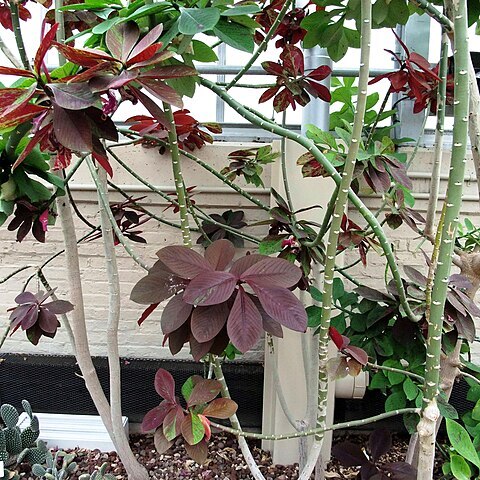Cyathia on peduncles to 1 cm long, c. 1 × 3 cm, with barrel-shaped involucres, all parts except the upper surface of the glands minutely puberulous; glands 4 spreading, c. 4 × 8 mm, transversely elliptic, outer margin with 6–10 finger-like processes c. 8 mm long, branching several times at the tips and terminating in minute knobs, the glands yellowish-green, with reddish processes; lobes c. 3 × 5 mm, rounded, margin sharply toothed, often with a longer central tooth to 1.5 mm long, densely puberulous on both surfaces.
Leaves sessile, glabrous; stipules glandular, minute, deciduous; lamina to 30 × 3 cm, linear to linear-lanceolate, acuminate at the apex, rounded at the base, entire, midrib prominent on the lower surface, pale green and slightly glaucous.
Female flower: perianth obvious below the ovary, irregularly and acutely lobed with lobes to 1.5 mm long; ovary minutely puberulous; styles 1 cm long, joined to nearly halfway, with shortly bifid thickened rugulose apices.
Bracts sessile, c. 4 × 4 cm when mature, deltoid, apex acuminate to c. 2 cm long, base subcordate, lower surface minutely puberulous at least towards the base, bracts below the umbel larger and longer.
Cymes in terminal 3-branched umbels produced on a leafless peduncle to 10(15) cm long, with primary rays to 5(7) cm long, each forking up to 8 times, peduncle, rays and branches minutely puberulous.
A few-stemmed bush or sparingly branched tree 1.5–9 m high, with a smooth but horizontally grooved grey bark; branches semi-succulent, with large prominent closely-set leaf scars.
Seeds c. 6 × 5 mm, subglobose, slightly compressed laterally and obscurely 3-angled, surface minutely roughened, greyish-brown.
Fruit exserted on a curved pedicel to 1.5 cm long; capsule c. 13 × 17 mm, subglobose, glabrous when mature, tinged purplish.
Male flowers: bracteoles many, fan-shaped, deeply divided, feathery at the apices; stamens 14.5 mm long.

